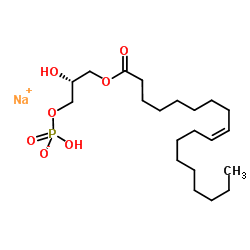油酰基-L-α-溶血磷脂酸 钠盐

油酰基-L-α-溶血磷脂酸 钠盐结构式

|
常用名 | 油酰基-L-α-溶血磷脂酸 钠盐 | 英文名 | 1-Oleoyl lysophosphatidic acid sodium salt |
|---|---|---|---|---|
| CAS号 | 22556-62-3 | 分子量 | 458.502 | |
| 密度 | N/A | 沸点 | 581.5ºC at 760mmHg | |
| 分子式 | C21H40NaO7P | 熔点 | N/A | |
| MSDS | 中文版 美版 | 闪点 | 305.5ºC |
|
Somatostatin inhibits cell migration and reduces cell counts of human keratinocytes and delays epidermal wound healing in an ex vivo wound model.
PLoS ONE 6 , e19740, (2011) The peptide hormone somatostatin (SST) and its five G protein-coupled receptors (SSTR1-5) were described to be present in the skin, but their cutaneous function(s) and skin-specific signalling mechanisms are widely unknown. By using receptor specific agonists... |
|
|
Lysophosphatidic acid alters the expression profiles of angiogenic factors, cytokines, and chemokines in mouse liver sinusoidal endothelial cells.
PLoS ONE 10(3) , e0122060, (2015) Lysophosphatidic acid (LPA) is a multi-function glycerophospholipid. LPA affects the proliferation of hepatocytes and stellate cells in vitro, and in a partial hepatectomy induced liver regeneration model, the circulating LPA levels and LPA receptor (LPAR) ex... |
|
|
Lysophosphatidic acid stimulates prostaglandin E2 production in cultured stromal endometrial cells through LPA1 receptor.
Exp. Biol. Med. 234 , 986-93, (2009) Lysophosphatidic acid (LPA) has been shown to be a potent modulator of prostaglandin (PG) secretion during the luteal phase of the estrous cycle in the bovine endometrium in vivo. The aims of the present study were to determine the cell types of the bovine en... |
|
|
γ-Tubulin localizes at actin-based membrane protrusions and inhibits formation of stress-fibers
Biochem. Biophys. Res. Commun. 408 , 248-52, (2011) Highlights ► γ-Tubulin localizes at actin-based membrane protrusions. ► The localization was supported by knock-down and overexpression of γ-tubulin. ► Expression of tagged γ-tubulin dramatically inhibited the formation of stress-fibers. ► This phenotype is s... |
|
|
Lysophosphatidic acid: mitogen and motility factor.
Biochem. Soc. Trans. 31 , 1209-1212, (2003) LPA (lysophosphatidic acid), the simplest of al glycerophospholipids, is a potent inducer of cell proliferation, migration and survival. It does so by activating its cognate G-protein-coupled receptors, four of which have been identified. LPA receptors couple... |
|
|
A single receptor encoded by vzg-1/lpA1/edg-2 couples to G proteins and mediates multiple cellular responses to lysophosphatidic acid.
Proc. Natl. Acad. Sci. U. S. A. 95 , 6151-6156, (1998) Extracellular lysophosphatidic acid (LPA) produces diverse cellular responses in many cell types. Recent reports of several molecularly distinct G protein-coupled receptors have raised the possibility that the responses to LPA stimulation could be mediated by... |
|
|
Differential effects of sphingosine 1-phosphate and lysophosphatidic acid on endothelial cells.
Biochim. Biophys. Acta 1582 , 190-196, (2002) This review discusses multiple effects of sphingosine 1-phosphate (S1P) and lysophosphatidic acid (LPA) on endothelial cells and proposes that S1P and LPA are important regulators of the vascular system. Two physiologic sources of S1P and LPA are platelets an... |
|
|
The G-protein G13 but not G12 mediates signaling from lysophosphatidic acid receptor via epidermal growth factor receptor to Rho.
J. Biol. Chem. 273 , 4653-4659, (1998) Lysophosphatidic acid (LPA) utilizes a G-protein-coupled receptor to activate the small GTP-binding protein Rho and to induce rapid remodeling of the actin cytoskeleton. We studied the signal transduction from LPA receptors to Rho activation. Analysis of the ... |
|
|
Lysophosphatidic acid potentiates ACh receptor currents by G-protein-mediated activation of protein kinase C.
Brain Res. Mol. Brain Res. 50 , 121-126, (1997) The effect of lysophosphatidic acid (lysoPA) on acetylcholine (ACh)-evoked currents was examined using normal and mutant Torpedo nicotinic ACh receptors expressed in Xenopus oocytes. LysoPA enhanced ACh-evoked currents in a washing time- and dose-dependent ma... |
|
|
Lysophosphatidic acid induces anxiety-like behavior via its receptors in mice.
J. Neural Transm. Gen. Sect. 122(3) , 487-94, (2015) Lysophosphatidic acid (LPA) is a potent bioactive lipid mediator with diverse biological properties. We previously found altered expression of the LPA-related genes in rodents after treatment with sertraline, which is widely used to treat anxiety disorders an... |